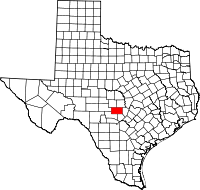Texas German
| Texas German | |
|---|---|
| Native to | Texas |
| Region | Texas Hill Country |
Native speakers | 4,000–6,000, declining (2013)[1][2] |
|
Indo-European
| |
| Language codes | |
| ISO 639-3 | – |
| Glottolog | None |
Texas German (German: Texasdeutsch) is a German language dialect spoken by descendants of German immigrants who settled in Texas in the mid-19th century. These "German Texans" founded the towns of Bulverde, New Braunfels, Fredericksburg, Boerne, Walburg, and Comfort in Texas Hill Country, and Schulenburg and Weimar to the east.
History and documentation
While most heritage languages in the United States die out by the third generation, Texas German is unusual in that most German Texans continued to speak German in their homes and communities for several generations after settling in the state.[3] During World War I, Texas education rules were established mandating English-only instruction, requiring children to learn English in school regardless of what was spoken outside it. Due to the growth of these communities and cultural bias during both World War I and World War II, Texas German speakers drifted towards English and few passed the language to their descendants.[4] By 1950, the number of new speakers of the language was virtually zero.[5]
The dialect is near extinction, as it is now spoken almost exclusively by a few elderly German Texans. Currently, Dr. Hans Boas at the University of Texas is recording and studying the dialect,[6] building on research originally performed by Dr. Glenn Gilbert of Southern Illinois University Carbondale in the 1960s.
It's an odd mixture of English and 19th-century German," says Boas ... "Hardly any of the Texas Germans speak alike. There's a lot of variation in the dialect. Texas German borrows about 5 to 6 percent of its vocabulary from English, creating words like 'der cowboy.'[7]
Boas' book on the language, The Life and Death of Texas German, describes the German dialects which may have been the source of the language spoken in Texas.[8]
A feature-length documentary project named "All Gut Things" is currently being developed about the language and will be completed by April 2017.[9]
Current distribution and population

Some 1,035 people report speaking German at home in Fredericksburg,[10] the town with the largest community of Texas German speakers, representing 12.48% of the total population, 840 in New Braunfels,[11] 150 in Schulenburg,[11] 85 in Stonewall,[12] 70 in Boerne,[11] 65 in Harper,[13] 45 in Comfort[14] and 19 in Weimar,[11] all of which except for Schulenburg and Weimar, lie in the traditional Texas German heartland of the Hill Country. Gillespie County, with the communities of Fredericksburg, Harper, Stonewall, and Luckenbach, has a German-speaking population of 2,270, 11.51% of the county's total. In all, 82,100 German-speakers reside in the state of Texas,[11] including European German speakers.
Comparisons with German and English
Texas German is adapted to U.S. measurement and legal terminologies. German words were invented or English was "Germanicized" for words not present in 19th-century German. In some cases, these new words also exist in modern Standard German, but with a different meaning. For instance, the word Luftschiff (used for "airplane") means airship in Standard German.
The table below illustrates some examples of differences:
| American English | Texas German | Literal translation | Standard German | Literal translation |
|---|---|---|---|---|
| skunk | Stinkkatze | stink cat | Stinktier | stink animal |
| airplane | Luftschiff | airship | Flugzeug | flight gear |
| blanket | Blanket | blanket | Decke | blanket |
| gone | all | empty; gone | leer; alle | empty; used up |
See also
- German Texan
- New Braunfels, Texas
- Texas German Dialect Project
- "All Gut Things" crowdsourcing project
- Czech Texan
- Pennsylvania German
- Hutterite German
- Plautdietsch
- German language in the United States
References
- ↑ Vince, Katy (July 2013). "Auf Wiedersehen to a Dialect". Texas Monthly. Retrieved April 7, 2015.
- ↑ Adam, Thomas (2005). Germany and the Americas. ABC-CLIO. p. 1031. ISBN 9781851096282.
- ↑ "Documentarians fight to preserve dying Texas-German dialect". The Daily Texan. 2016-10-05. Retrieved 2016-10-26.
- ↑ O'Connor, Kyrie (2013-03-10). "Texas German dying out: language of settlers aging with its users". San Antonio Express-News. Retrieved 2013-06-02.
- ↑ "Documentarians fight to preserve dying Texas-German dialect". The Daily Texan. 2016-10-05. Retrieved 2016-10-26.
- ↑ "German dialect in Texas is one of a kind, and dying out". BBC News. 2013-05-14. Retrieved 2013-06-02.
- ↑ "Vanshing Voices: Linguists work with remaining speakers of dying languages to preserve cultural memories". University of Texas at Austin. 2010-01-11. Retrieved 2013-06-02.
- ↑ Microsoft Word - Life and Death of Texas German review - Review of Life and Death of Texas German.pdf (PDF), retrieved 2013-06-02
- ↑ "Documentarians fight to preserve dying Texas-German dialect". The Daily Texan. 2016-10-05. Retrieved 2016-10-26.
- ↑ MLA Language Map Data Center results, Fredricksburg, Texas, all languages
- 1 2 3 4 5 MLA Language Map Data Center results, Fredericksburg, Texas
- ↑ MLA Language Map Data Center results, Stonewall, Texas
- ↑ MLA Language Map Data Center results, Harper, Texas
- ↑ MLA Language Map Data Center results, Comfort, Texas
- Boas, Hans C (2009). The Life and Death of Texas German. Publication of the American Dialect Society. Duke University Press. ISBN 9780822367161.
External links
- Texas German Dialect Project
- Article about Texas German – Spiegel online (German)
- "German dialect in Texas is one of a kind, and dying out". BBC News. 14 May 2013.